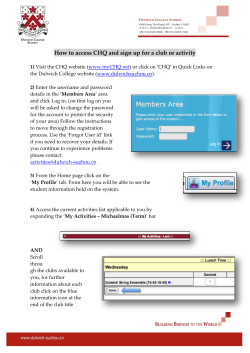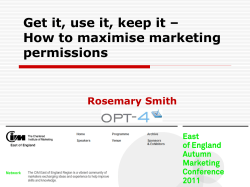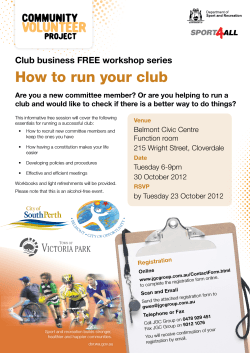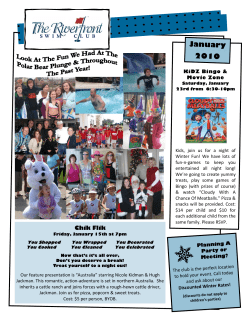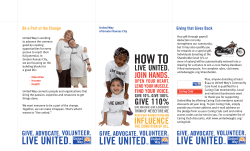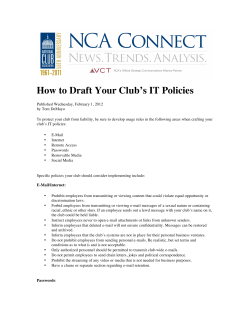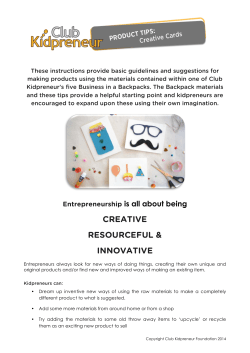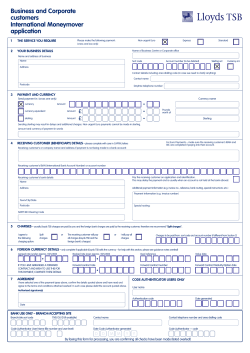
‘How to’ Funding Guide Lloyds TSB Foundation for NI (Community Grants Programme)
‘How to’ Funding Guide ‘How to’ Funding Guide specific to: Lloyds TSB Foundation for NI (Community Grants Programme) IRFU (ULSTER BRANCH) David Johnston Club & Community Development Officer 028 9049 3111 ext 257 david.johnston@ulsterrugby.com September 2013 1 ‘How to’ Funding Guide Table of Contents Section Page Number 1. INTRODUCTION 3 2. OVERVIEW 4 3. EXAMPLE PROJECTS 6 4. STEP BY STEP GUIDE & SUPPORTING INFORMATION 7 5. KEP POINTS 8 2 ‘How to’ Funding Guide SECTION 1 – INTRODUCTION IRFU (Ulster Branch) have developed this ‘How to’ funding guide as a resource to provide a succinct support mechanism for Clubs wishing to apply for grant funding. Each ‘How to’ funding guide has been developed for a specific grant programme, details of which are within the document. Disclaimer IRFU (Ulster Branch) have developed this resource in good faith and have endeavoured to ensure that the information contained within is accurate at date of production. Clubs are responsible for ensuring that information contained within their own submission meets the up to date requirements of the grant programme. 3 ‘How to’ Funding Guide SECTION 2 – OVERVIEW Grant Programme Name: Lloyds TSB Foundation for NI (Community Grants Programme) Link to Grant Programme website: http://www.lloydstsbfoundationni.org/programmes/communitygrant-programme Introduction The Lloyds TSB Foundation for NI is a grant-giving Foundation whose income is derived from a shareholding in Lloyds Banking Group. The Foundation is independent of the Group. The overall policy of the Foundation is to support underfunded charities that enable people, especially disadvantaged or people with special needs, to play a fuller role in the community. The overall aim of the Foundation is; To support underfunded, grassroots charities that enable people, especially disabled and disadvantaged people, to play a fuller role in society. The Foundation has two main target areas to which it seeks to allocate funds: 1. Social and Community needs 2. Education and Training Deadlines: The closing dates for applications are normally the second Friday of January, April, July and October. Applications will be accepted online until 5pm on each closing date. Always check the website for the latest closing dates http://www.lloydstsbfoundationni.org/programmes/community-grant-programme Amount The average grant is in the region of £3,000 - £4,000, but there is no min or max amount set. Eligibility Clubs wishing to apply must be registered as a charity with HMRC Clubs wishing to apply must have an annual income of less than £1 million 4 ‘How to’ Funding Guide What the Foundation will NOT fund Sponsorship or marketing appeals Activities that collect funds for subsequent redistribution to others Fundraising events or activities Loans or business finance Expeditions or overseas travel Construction of and extension to buildings Notes Applicants are required to leave one year between applications whether they are successful or unsuccessful Organisations who have received 3 years consecutive funding must leave 2 years before re-applying. Application form and guidance notes The online application form, guidance notes and other useful information can be found online using the following link http://www.lloydstsbfoundationni.org/programmes/community-grant-programme 5 ‘How to’ Funding Guide SECTION 3 – EXAMPLE PROJECTS Example Project 1 New equipment is a priority for the Club in addition to new first aid supplies and renewed first aid training. This provision is key to support the current activities and continued development and expansion of our youth and adult activities within the club and allow the club to continue the important outreach work within the surrounding community. Costs could include essential equipment costs, first aid supplies and first aid training costs. Example Project 2 Capacity building of existing/new volunteers. Project will enable 5 volunteers to attend coach education qualifications and therefore enhance their capacity to deliver high quality training to our participants as well as enhancing the volunteers personal, social and educational development. This is a major step in the Club's overall development plans. Costs could include the price of coaching qualifications. Example Project 3: Facility hire for the implementation of rugby based initiatives for the local community which will help to increase the opportunities for additional young people and adults to take part in healthy and capacity building activities. Costs could include the price of facility hire (NB, you cannot hire your own facilities). Example Project 4: Promotion of life skills and independent living skills for disabled people, using sport and in particular tag rugby to do so. The project could be based over a 20 week period, enabling people with disabilities to socially interact, enhance confidence and self-esteem, develop a new motivation and benefit from stimulated cognitive activity. Costs could include facility hire (you cannot hire your own facilities), volunteer training to allow for delivery of activities, essential equipment required to deliver activities and/or building in expert/specialised facilitators to deliver some of the activities. The list of example projects above is not exhaustive. Please note that your project should be based on an identified need. If you require clarification on a project idea or anything else regarding an application, please contact David Johnston (IRFU Ulster Branch, Club & Community Development Officer) via phone or email. Office telephone – 02890 493111 ext 257 Mobile telephone – 07767168981 Email – david.johnston@ulsterrugby.com 6 ‘How to’ Funding Guide SECTION 4 – STEP BY STEP GUIDE & SUPPORTING INFORMATION Step by Step guide Discuss your project with a grants advisor at the Foundation before submission to ensure it fits within the criteria. This step is not mandatory but is advisable. Access the online application form http://www.lloydstsbfoundationni.org/programmes/community-grantprogramme/application-process Complete the online application form and either upload or send hard copies of the supporting documents (these are listed below). Your application form will be assessed. As part of this, you may receive a telephone call, or a member of our staff may visit your organisation. You will be informed of a decision by letter within 11 weeks of the closing date Supporting documents All organisations that wish to submit an application form have to either upload or send hard copies of the following supporting documents: Most recent Annual Report OR signed Minutes of the most recent AGM Most recent Audit OR Independently Examined Accounts o Audited accounts must be signed by both the Auditor and Chairperson or Treasurer of the organisation applying. o Independently examined accounts must be signed by both an individual with the requisite ability who is external to the organisation, and the Chairperson or Treasurer of the organisation. HM Revenue & Customs Letter of Recognition showing Charitable Status o This must relate directly to your organisation and confirm charitable status Signed and Adopted Constitution o Must be adopted by the organisation’s committee and have a handwritten signature by 2 committee members, one of which must be an office bearer. List of office bearers o Must contain names, positions and addresses of the current office bearers. Job Description and Personnel Specification o Only if applying for a grant that supports salary costs. 7 ‘How to’ Funding Guide SECTION 5 – KEY POINTS The following section outlines the key points for your Club to consider when completing the main questions in the application form. Please do not complete your answers in this document – this is for guidance only. The official online application form can be found on the Lloyds TSB Foundation for Northern Ireland website by following the link on page 4 or 5 of this document. Application form - Main Questions and Answers Present Activities Include details about the day-to-day activities in your organisation, detailing the services you provide. Describe your organisation and detail who benefits from it. Some further/specific details you should include are: Number of participants the Club caters for Age ranges of participants benefiting from the Clubs activities Detail any specific programmes and initiatives delivered by Club Detail the Clubs community involvement/outreach work Project Description Outline the exact activities that will be taking place during the project – be specific – include expected participant numbers, frequency of activity, location, time periods etc. Describe how you identified a need for the project – did you undertake a survey? Have you been asked to provide this service? State the overall aim of the project, e.g. “To improve social facilities for disadvantaged older people in Anytown”. Outline 3 objectives for your project Keeping your overall aim in mind, list three objectives to describe how you will fulfil this aim. Your objectives should be measurable by including quantitative targets which will be used to evaluate the project’s success. For example, using Anytown as set out above, your objectives might be; To increase the number of social evenings for disadvantaged older people from 1 per month to 1 per week To run a crafts sessions once per month To provide monthly talks for the older people 8 ‘How to’ Funding Guide Who will be benefiting directly from your project? Describe the type of people your project will support, e.g. young people from low income households, children with physical disabilities, adults with low educational attainment/qualifications. In this question, use your own knowledge of the participants as well as providing some statistics from NISRA (Northern Ireland Statistics and Research Agency) and/or PSNI statistics on crime/anti-social behaviour/drug abuse etc in your area. Also, describe HOW the project participants will be benefit from the project. Make sure the project fits with the needs you are trying to deal with. E.g. disadvantaged volunteers going through coaching qualifications will help develop their educational achievement, increase qualifications and improve important life skills. It will also help the Club sustain community activities and provide further initiatives for the benefit of the disadvantaged children, young people and adults. Measuring success In this section you will need to illustrate how you will judge the success of your project in relation to the objectives you have set. Methods you use will depend on the specific project, however, some general ideas are: Record participant numbers Record participant retention rates Consult participants through short evaluation forms Informal consultation with participants, other Club members and/or parents if applicable Conduct visual assessment throughout the project Analyse results in a sub-committee/focus group and results will be used for the development of future projects Sustainability Explain how you plan to continue the project beyond the life of Lloyds TSB Foundation funding. Again, this depends on the particular project in question, however, some general ideas are: You will use the enhanced internal capacity of volunteers to help sustain the operations of the Club. You will seek to raise further funds to continue the project through sponsorship, donations, funding bodies. 9
© Copyright 2025
